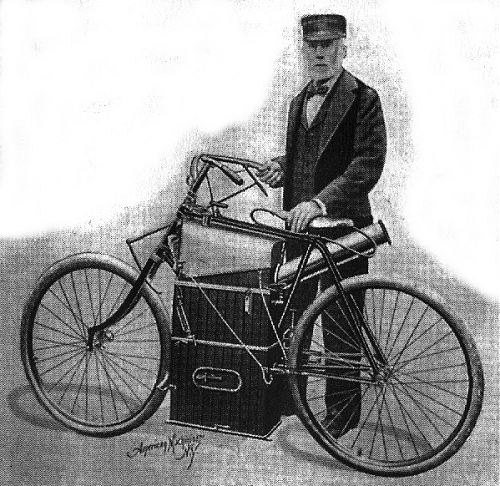Have you ever wondered what people who don’t ride motorcycles do for fun? I’ve given this loads of thought, and I’m buggered if I know. But today they have a choice — the bikes are there; they just have to go out and buy ’em. Then I had a scary thought; what did would-be bikers do for fun before there were bikes? The answer to that conundrum is easily found if you trawl the internet for a while. Bikers without motorcycles devoted all their energies to inventing the things.
Long before 1969, when Honda introduced its 750 Four and changed the face of motorcycling forever, little boys in men’s bodies were attaching wheels to rudimentary frames and trying to get the resulting contraptions to go faster. Michelangelo reputedly designed a bicycle in the 14th century, but it wasn’t till 1790 that a Frenchman called Comte Mede de Sivrac actually built one — a sad device made of wood, with no brakes or steering. Worst of all, because the machine lacked pedals, the poor blighter riding the thing had to scoot his feet along the ground to propel it, which must have created a bit of a stir among the birds when he arrived at the pub.
In 1816 or so, Baron Karl von Drais hit upon the concept of a steerable front wheel, but more than 50 years went by before a New Yorker called William van Anden thought to add pedals to the front axle to enable the rider to propel himself forwards without going through three pairs of shoes a day.
Unfortunately, the only way to get the bike to go faster with that system was to raise the gearing by increasing the diameter of the front wheel enormously. This led to some rather unfortunate handling quirks, not to mention lots of head injuries when riders grabbed their newly invented front brakes and sent the entire machines pivoting rapidly around their axles.
While this energetic mob was trying to get its bikes to move effortlessly forward without spitting them off, another crew — the bikers of the time, I suppose — was labouring away at getting the things to run, literally, under their own steam. A forward-looking American called Sylvester Howard Roper demonstrated his charcoal-burning, twin-cylinder steam bicycle at fairs around the US in 1869. The Roper Steam Cycle had handlebar twist-grip controls, and the engine’s con-rods were linked directly to a crankshaft on the rear wheel. The boiler was located precariously beneath the seat with its funnel protruding upwards and rearwards, so carrying a pillion was presumably a no-no. The spectacle of riders firing up the boiler, building up a head of steam and then riding the thing to work must have been well worth getting up early for.
There are claims that the Germans built an earlier steam motorcycle called the Vocipedraisiavaporianna in 1818, using steam turbines mounted in each wheel. Drawings of this wondrous beast still exist, but the machine itself seems to have disappeared without trace. Maybe the Germans lied — they started two world wars, after all, so you can’t really trust them.
What did undoubtedly exist was the Von Sauerbronn-Davis steam velocipede of 1883. Aware of the perils of stoking a fire while balancing on two wheels, the designers built a trike rather than a bike, using petrol to fire the boiler. My guess is that this machine may have brought the invention of the fire extinguisher forward by some decades.
Steam power remained in vogue, despite its inconvenience, until 1885, when Gottlieb Daimler developed the first petrol-engined motorcycle. Then the game was on in earnest, but there was still a long road ahead. Although Felix Millett understood that more cylinders equalled more power, he obviously knew nothing about unsprung weight and centrifugal force. The machine he invented in 1892 had five cylinders, which was good, but his idea of mounting them radially in a crankcase, forming the hub of the rear wheel, was not so clever. The cylinders rotated within the wheel around a stationary crankshaft, and the 0,7bhp machine could reach all of 35km/h, which must have been quite alarming under the circumstances.
The Italian who invented the pusher-assisted bicycle in 1893, with the engine mounted separately on a trailer, probably did so from a sense of self-preservation — he was, presumably, an old steam-bike rider who was wary at the prospect of roasting his chestnuts. The bike appears to have had a fixed cog, which would explain the floorboards that kept the rider’s feet out of the way of the whirling pedals. Floorboards wouldn’t have helped the rider of the 1906 Ananzi propeller cycle, though. This curious bicycle used its engine to drive a long shaft protruding forwards, to which was attached an aircraft propeller.
After the first confused decade of the 20th century, things stabilised nicely, and by the 1930s we had wonders like the DKW supercharged and intercooled split-single liquid-cooled two-strokes. In 1937, BMW used a supercharged 500cc boxer twin to set a 279km/h world speed record that would stand for 14 years. Today we can buy street bikes that go quicker than that with the VAT you’d pay on a top-of-the-range BMW or Mercedes, and we have all those old codgers with the burnt nuts and cracked skulls to thank for that.
My question still hasn’t been answered, though. What do people who don’t ride motorcycles do for fun?



